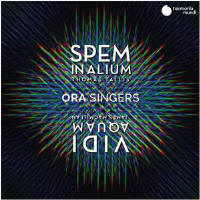Texte paru dans: / Appeared in: |
|
|
Outil de traduction ~ (Très approximatif) |
|
|
Reviewer: J.
F. Weber
For this spectacular
recording, the Ora Singers commissioned James MacMillan to compose a
companion piece to Spem in alium, the celebrated 40-part motet of Thomas
Tallis. MacMillan chose just the right text, Vidi aquam, the antiphon for
the sprinkling of holy water before high Mass on Sunday in Eastertide (it
replaces the more familiar Asperges me used during the rest of the year).
Not surprisingly, he used Tallis’s scoring for eight five-part choirs,
adopting Tallis’s plan of using the voices sparingly, adding voices
successively, and saving all 40 voices for climaxes. Just as Tallis produced
a bone-chilling change of harmony toward the end at the crucial word “Respice,”
MacMillan makes his first outburst at the first “alleluia,” then in the
second half of the text treats the crucial “Et omnes” similarly, going on to
build up the concluding alleluias with an unexpected harmonic shift at the
end. It is a brilliant work, combining a sense of Tudor polyphony with
modern textures, from Britain’s leading contemporary composer of sacred
music.
The two matching works frame a
group of 13 other pieces, all from the 16th century except for two brief
chant antiphons. Two other Tallis selections are In jejunio et fletu and
Derelinquit impius, while William Byrd gives us Domine, salva nos and Fac
cum servo tuo. Three other composers were foreign-born but long resident in
England. The Italian diplomat-musician Alfonso Ferrabosco the elder is
represented by In monte Oliveti, Decantabat populus Israel, and Judica me
Domine. The Fleming Derrick Gerarde (c. 1540–1580), heard here in O
souverain Pasteur and Tua est potentia, served the earl of Arundel at
Nonsuch palace in London, which he had bought from Queen Mary in 1556, then
completing the unfinished structure. He has been heard on records earlier in
Dulces exuviae (Fanfare 26:1), where an alternate first name (Theodoricus)
was given on the CD, and twice in Sive vigilem (39:1 and 39:5). An older
Fleming, Philip van Wilder, who served at Henry VIII’s court, is heard in
Pater noster and Vidi civitatem; the former was heard recently from
Gallicantus (41:1). The Flemish-born composers offer an audible contrast to
the Tudor sound.
We have already had other
40-part works that framed a program with the Tallis masterpiece. The most
obvious coupling is the only extant version of Tallis’s motet Sing and
glorify. The lost Latin text had to be fitted to the music that survived
with the contrafact text, presumably a simple task until Hugh Keyte found he
could improve on previous efforts. Harry Christophers bookended his Music
for Monarchs and Magnates (Coro 16016) with the two versions of Tallis in
spectacular surround sound (not reviewed here). Paul Van Nevel framed a
polychoral program (19:4) with Tallis and Striggio’s Ecce beatam lucem,
thought to be the motivation for Tallis until the real model, Striggio’s
Mass, was discovered (35:1). Antony Pitts composed XL, set to the beginning
of Psalm 39 (40), chosen for its numerical place in the Hebrew Bible and
named, as Superbowl fans will recognize, for the number of voices; Simon
Halsey framed a collection of massive choral works with Tallis and Pitts in
stunning surround sound (29:6). To me, MacMillan has given us the best foil
for the sound of Spem in alium yet. I only regret that it wasn’t issued in
surround sound, as the Christophers and Halsey discs were (Van Nevel later
remade the Tallis, 30:5, with other polychoral works in surround sound). The
stereo sound doesn’t give the spatial effect that I have heard on other
stereo recordings played on my surround system. But if the music is
paramount, this new disc wins out for the best coupling. The accompanying DVD is not mentioned in the booklet except for a description on the back cover. It consists of four parts: an account of the recording, complete performances of the two main works, and Digby’s enlightening interview with MacMillan. The video adds to an appreciation of the two 40-voice works, and the array of microphones suggests that they were recorded in surround sound. That impression is strengthened by the availability of each selection on download in ordinary and binaural versions, whatever that distinction may mean. I don’t know why this is only the second of six Ora CDs reviewed here, since the first (40:4) got such close attention. Like this disc, that collection of pieces was framed by a pair of works old and new: Allegri’s celebrated setting of Psalm 50 (51) and a new setting of the text by the same James MacMillan. Digby has chosen an eminent composer in commissioning a motet to match Tallis’s. Of the 27 recordings of Spem in alium by my count, five of them in Super Audio, this one coupled with MacMillan’s motet is unique. Do compare it with the others mentioned, but then return here to listen to Vidi aquam again and again.
| |
|
|
|
|
Cliquez l'un ou l'autre
bouton pour découvrir bien d'autres critiques de CD |
|




